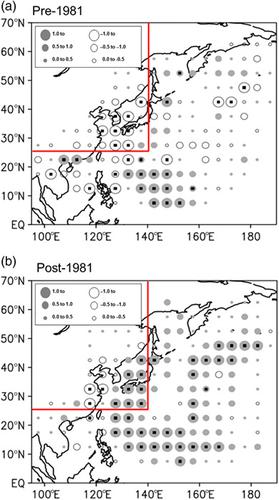当前位置:
X-MOL 学术
›
Atmos. Sci. Lett.
›
论文详情
Our official English website, www.x-mol.net, welcomes your feedback! (Note: you will need to create a separate account there.)
Possible combined effect of El Niño–Southern Oscillation and Pacific Decadal Oscillation on Korea affecting tropical cyclone passage frequency
Atmospheric Science Letters ( IF 3 ) Pub Date : 2019-08-28 , DOI: 10.1002/asl.907 Jae‐Won Choi 1 , Hae‐Dong Kim 2
Atmospheric Science Letters ( IF 3 ) Pub Date : 2019-08-28 , DOI: 10.1002/asl.907 Jae‐Won Choi 1 , Hae‐Dong Kim 2
Affiliation

|
This study found that the passage frequency of tropical cyclones (TCs) affecting Korea has had negative correlations with the Pacific Decadal Oscillation (PDO) and the El Niño–Southern Oscillation (ENSO) since the early 1980s. To examine the actual combined effects of PDO and ENSO on the passage frequency of TCs affecting Korea, the positive PDO and ENSO years for 9 years and the negative PDO and ENSO years for 9 years were selected during the periods of 1951–1981 (pre‐1981) and 1982–2012 (post‐1981), and then the average difference between these two phases was analyzed. An analysis of anomalous stream flows at 500 hPa showed the formation of anomalous cyclonic circulations in an east‐to‐west direction from East Asia to the North Pacific both in the pre‐1981 and post‐1981 periods in the positive PDO and ENSO years. However, the anomalous cyclones in East Asia were stronger in the pre‐1981 period, whereas the anomalous cyclones in the North Pacific were stronger in the post‐1981 period. Consequently, China, Korea and the west of Japan were affected by strong anomalous northerlies in the pre‐1981 period, and the TC passage frequency was lower in these regions as a result. In the post‐1981 period, these countries were affected by anomalous northwesterlies or anomalous westerlies.
更新日期:2019-08-28

























 京公网安备 11010802027423号
京公网安备 11010802027423号